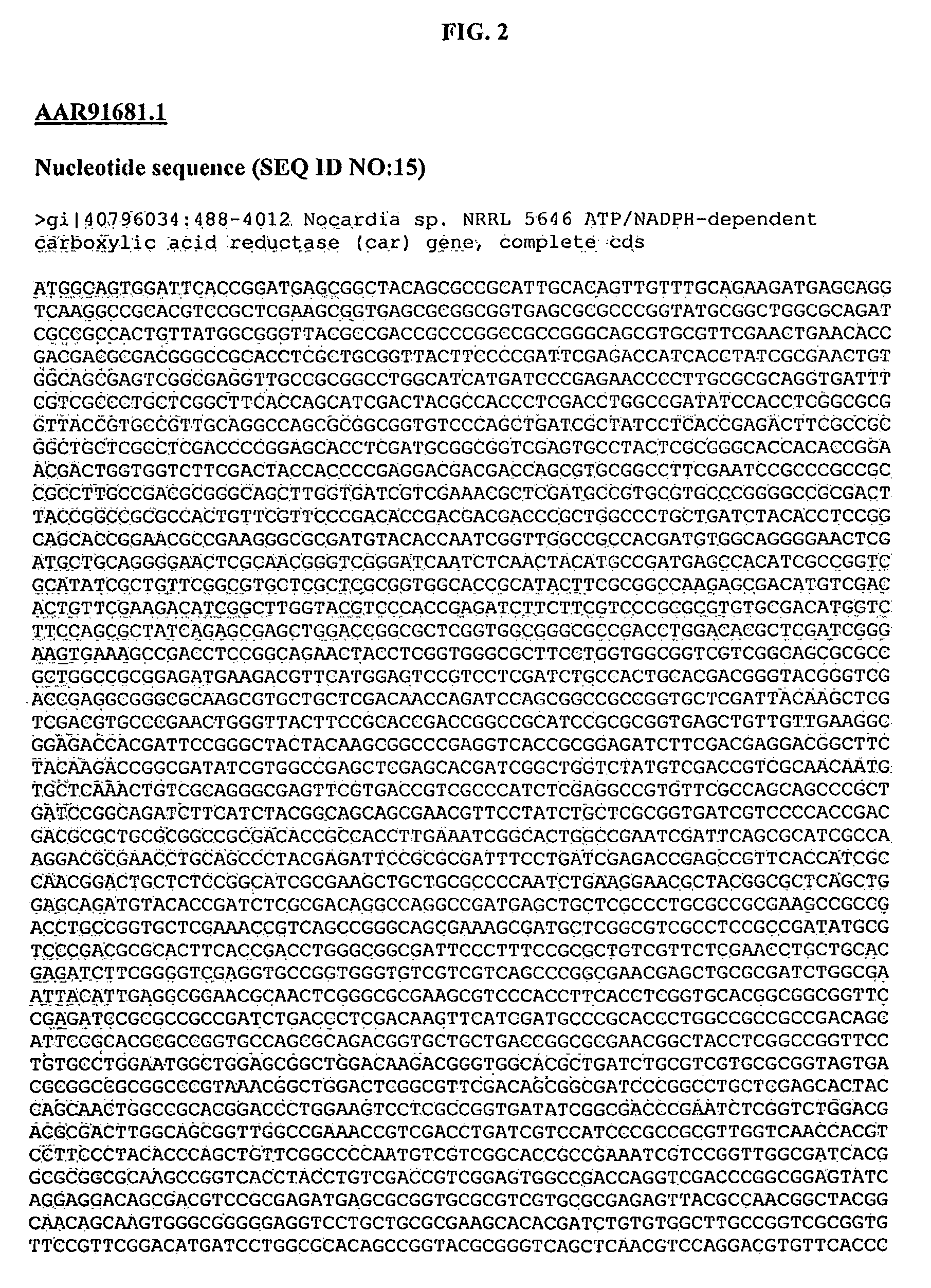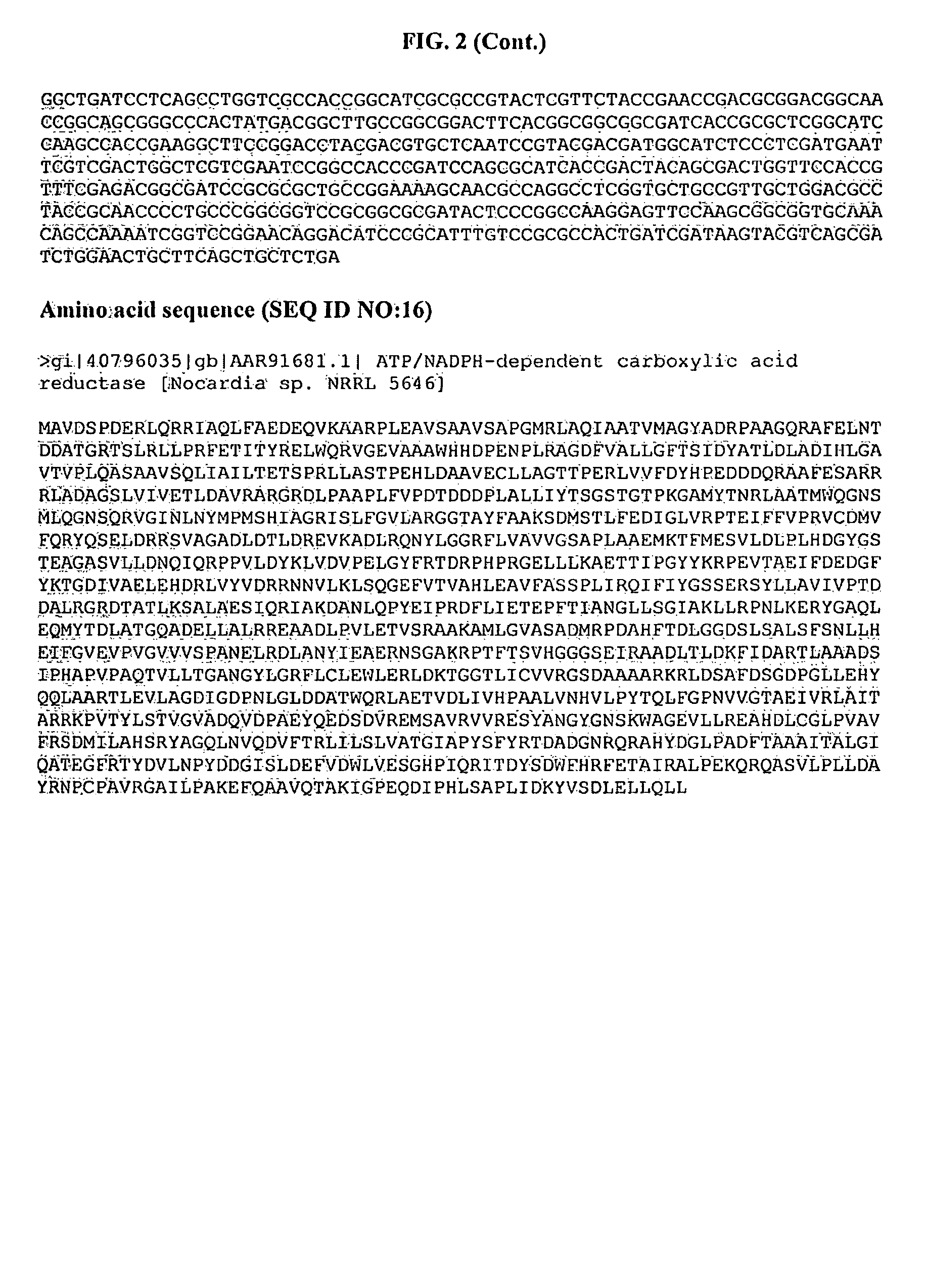Methods and compositions for producing fatty aldehydes
a technology of fatty acid and composition, which is applied in the field of methods and compositions for producing fatty aldehydes, can solve the problems of increasing the cost of petroleum products development, and requiring exploration of petroleum sources, so as to reduce and increasing the expression or activity of an endogenous fatty acid synthase
- Summary
- Abstract
- Description
- Claims
- Application Information
AI Technical Summary
Benefits of technology
Problems solved by technology
Method used
Image
Examples
example 1
Identification of Carboxylic Acid Reductase (CAR) Homologs
[0318]The carboxylic acid reductase (CAR) from Nocardia sp. strain NRRL 5646 can reduce carboxylic acids into corresponding aldehydes without separate activating enzymes, such as acyl-CoA synthases (Li et al., J. Bacteriol. 179:3482-3487, 1997; He et al., Appl. Environ. Microbiol. 70:1874-1881, 2004)). A BLAST search using the NRRL 5646 CAR amino acid sequence (Genpept accession AAR91681) (SEQ ID NO:16) as the query sequence identified approximately 20 homologous sequences. Three homologs, listed in Table 7, were evaluated for their ability to convert fatty acids into fatty aldehydes in vivo when expressed in E. coli. At the nucleotide sequence level, carA (SEQ ID NO:19), carB (SEQ ID NO:21), and fadD9 (SEQ ID NO:17) demonstrated 62.6%, 49.4%, and 60.5% homology, respectively, to the car gene (AY495697) of Nocardia sp. NRRL 5646 (SEQ ID NO:15). At the amino acid level, CARA (SEQ ID NO:20), CARB (SEQ ID NO:22), and FadD9 (SEQ ...
example 2
Expression of CAR Homologs in E. coli
A. Plasmid Construction
[0320]Three E. coli expression plasmids were constructed to express the genes encoding the CAR homologs listed in Table 7. First, fadD9 was amplified from genomic DNA of Mycobacterium tuberculosis H37Rv (obtained from The University of British Columbia, and Vancouver, BC Canada) using the primers fadD9F and FadDR (see Table 8). The PCR product was first cloned into PCR-blunt (Invitrogen) and then released as an NdeI-AvrII fragment. The NdeI-AvrII fragment was then cloned between the NdeI and AvrII sites of pACYCDuet-1 (Novogen) to generate pACYCDuet-1-fadD9.
[0321]The carA and carB genes were amplified from the genomic DNA of Mycobacterium smegmatis MC2 155 (obtained from the ATCC (ATCC 23037D-5)) using primers CARMCaF and CARMCaR or CARMCbF and CARMCbR, respectively (see Table 8). Each PCR product was first cloned into PCR-blunt and then released as an NdeI-AvrII fragment. Each of the two fragments was then subcloned betwe...
PUM
| Property | Measurement | Unit |
|---|---|---|
| temperature | aaaaa | aaaaa |
| pH | aaaaa | aaaaa |
| temperatures | aaaaa | aaaaa |
Abstract
Description
Claims
Application Information
 Login to View More
Login to View More - R&D
- Intellectual Property
- Life Sciences
- Materials
- Tech Scout
- Unparalleled Data Quality
- Higher Quality Content
- 60% Fewer Hallucinations
Browse by: Latest US Patents, China's latest patents, Technical Efficacy Thesaurus, Application Domain, Technology Topic, Popular Technical Reports.
© 2025 PatSnap. All rights reserved.Legal|Privacy policy|Modern Slavery Act Transparency Statement|Sitemap|About US| Contact US: help@patsnap.com



